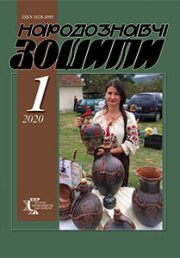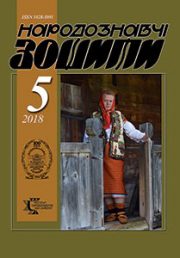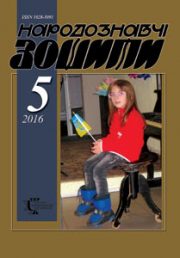The Ethnology Notebooks. 2019, № 6 (150), 1583—1590
UDK782:929(100)”1900/1950″
DOI https://doi.org/10.15407/nz2019.06.1583
MUKHINA Larysa
ORCID ID: https://orcid.org/0000-0002-2381-7297
post-graduate student of study at Sumy
State Teachers’ Training University named
after A.S. Makarenko; a teacher-methodist
of solo and choral singing of Sumy children’s music
school № 2; a teacher of solo singing of
Department of choral conducting, vocal and
methods of music education of Sumy State
Teachers’ Training University named
after A.S. Makarenko; a soloist-vocalist
of Sumy oblast philharmonic society
87, Romens’ka Str., 40002, Sumy, Ukraine
e-mail: Lorele_a@ukr.net
Abstract. The articledealswithanoeuvre of the famousUkrainianoperasingerIvanNikiforovichSteshenko (1894—1937). Basedon a widerange of sources, the authorgivescharacteristics of the foreignperiod of the singer’sbiography. The work of I.N. Steshenko in connectionwith the development of worldoperaticart of the firsthalf of the twentiethcenturywasanalyzed. The authorcomes to the conclusionthat the influence of the Europeanculturalprocess, the organicpart of whichwasanoperacareer, isclearlytraced in the work of I.N. Steshenko. Beingfromhisyouth a brightrepresentative of the uniqueUkrainianschool of choralsinging, as a professionaloperasinger, heisformedwithin the framework of the Europeanoperatradition, to whichhisteachersbelonged. The flowering of I.N. Steshenko’s creativecareerfallson the Americanperiod of hiscreativebiography. According to the examination of the actualmaterial, I.N. Steshenkowas a master of Europeanoperaticart; hiscreativestylewasformedon the bestexamples of the Europeanschool of operaart and wasfurtherrefined in the Americanoperaduring the period of itsflowering in the 20’s of the twentiethcentury. I. Steshenko, thus, actsas a bearer of the Europeanoperatraditionon the nationalstage and one of the mostsignificantUkrainiansoloists of the firsthalf of the twentiethcentury.
The influence of the European cultural process is clearly traced in the creative activity of I.N. Steshenko, his creative career was an organic part of this process. Being a bright representative of a unique Ukrainian school of choral singing from his youth, as a professional opera singer, he was formed within the framework of the European opera tradition to which his educators belonged. The heyday of his creative career was in the American period of his creative biography. For I.N. Steshenko, the period of work in the United States was a period of prosperity; he had the opportunity to enrich his creative repertoire and to take part in innovative opera projects, in particular, in the first production of Wцzzeck by A. Berg. According to the examination of the actual material, I.N. Steshenko was a master of European opera art; his creative style was formed on the best models of the European School of Opera and was perfected in the American opera during its heyday in the 1920’s of the 20th century.
Keywords: creativity of Ivan NikiforovichSteshenko, opera, history of operatic art.
Received 22.10.2019
REFERENCES
Bezrodnii, E. (1973). In the Constellation of Vocalists. Vitchyzna, 12, 211—213 [in Ukrainian].
Berlin, V. (2000). Ukrainian Chaliapin. Vremia. Kharkiv [in Ukrainian].
Bryl, V. (1995). Ukrainian Chaliapin from Lebedyn. Zhyttia Lebedynshyny, 83 (8975) [in Ukrainian].
Denisova, G.M. (2007). Camilo Everardi and Umberto Mazetti — «Russian Italians». Bulletin of Culture and Arts, 2 (12), 102—110 [in Russian].
Dudchenko, V. (1996). Returned from Oblivion. Zhyttia Lebedynshyny, 36 (9031) [in Ukrainian].
Zhytkevych, A. (2019). Ukrainian Chaliapin. Retrieved from: http://meest-online.com/culture/ukrajinskyj-shalyapin/.(Last accessed: 17.06.2019).
Znamenshchykova, V. Ivan Nykyforovich Steshenko — the World-Famous Opera Singer from Lebedyn Retrieved from: http://ndcsoippo.at.ua/_fr/0/Snamenshukova.pdf (Last accessed: 17.06.2019).
Lysenko, I. (Ed.). (2014). Ivan Steshenko. Memories and Materials. Zhytomyr: Ruta [in Ukrainian].
Izvarina, O.M. (2013). Opera Art as a Phenomenon of Ukrainian Art Culture of the 60’s of the 19th — the First Third of the 20th Century: Historical Aspect (author’s abstract. dissertation). Kyiv [in Ukrainian].
Kapitonenko, O. (1998). He was Applauded by Chicago and Philadelphia. Ukrainian News, 15 (3293) [in Ukrainian].
Kaplan, E.I. (1969). Life in a Musical Theatre. Leningrad: Muzyka [in Russian].
Nakhatovich, D. (1922). Steshenko’s Concert. Svobodnaya Rossia [in Russian].
New Ukrainian Artist in New York. (1926, 4 november) [in Ukrainian].
Opera Prodigy Originally from Sumy Region. (2019). Panorama: Vsi Sumy [in Ukrainian].
Domestic Singers of 1750—1911: Dictionary. (1991). (Vol. 1). Moscow: Sov. Kompositor [in Ukrainian].
Sirakoz, N.I. (1929). Concert Performance by I. Steshenko. Freedom. New York [in Ukrainian].
Tartakov, G. (1978). The Book of I.V. Tartakov. Leningrad: Muzyka [in Russian].
Ebergard, T. (1922). Ivan Steshenko. Svobodnaya Rossia [in Russian].
Budionna, V. (2012, 13 november). Ukrainian Shaliapin. Day. Kyiv.
Noskowski, de L. (1964). Adamo Didur. The Record Collector, 16, 4—23.
Dutilloy, H. (1910). First Production of a Tchaikowsky Opera in America this Week. The New York Times.
Emerson, E. (1931). PHILADELPHIA NOTES. The American Magazine of Art, 22 (5), 398—399.
Griffel, M.R. (2018). Operas in German: a dictionary (Vol. 1—2). Lanham: Rowman & Littlefield.
Hart, P. (1994). Fritz Reiner: a biography. Evanston: Northwestern University Press.
Luigi Lucenti (Bass) (Milano, Italia 1866 — ?). Forgotten Opera Singers. Retrieved from: http://forgottenoperasingers.blogspot.com/2016/02/luigi-lucenti-bass-milano-italia-1866.html. (Last accessed: 17.06.2019).
Makaryk, I.R. (2004). Shakespeare in the Undiscovered Bourn Les Kurbas, Ukrainian Modernism, and Early Soviet Cultural Politics. University of Toronto Press.
Marsh, R.C., Pellegrini, N. (2006). 150 years of opera in Chicago. DeKalb: Northern Illinois University Press.
McN, W. (1931). Russian Opera and Ballet. The Musical Times, 72, 644—645.
The Metropolitan Opera: Archives. Retrieved from: http://archives.metoperafamily.org/archives/frame.htm (Last accessed: 17.06.2019).
Moore, E.C. (1930). Forty years of opera in Chicago. New York: H. Liveright.
Morgan, K. (2004). Fritz Reiner, maestro and martinet. Urbana: University of Illinois Press.
Music: Goossens-Bennett Opera. (1930). The Time.
Musical Notes from Abroad. (1926). The Musical Times. 67, 362—365.
Opera in Philadelphia: performance chronology 1950—1974. Retrieved from: https://docplayer.net/12352561-Opera-in-philadelphia-performance-chronology-1925-1949.html. (Last accessed: 17.03.2019).
Philadelphia La Scala Opera Company. Retrieved from: https://wikivisually.com/wiki/Philadelphia_La_Scala_Opera_Company (Last accessed: 17.03.2019).
Watkins, G. (2003). Proof through the night: music and the great war. Berkeley: University of California Press.






